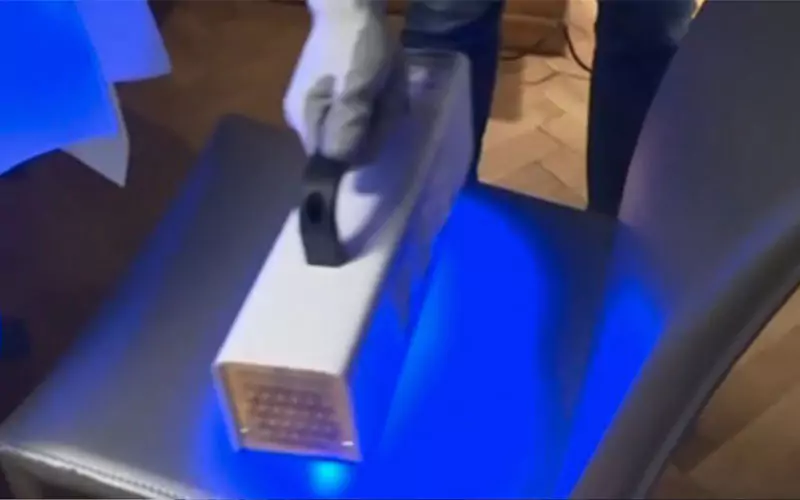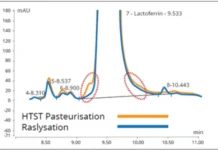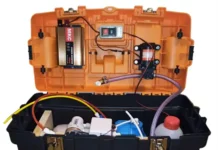Tatiana Koutchma, Ph.D., research scientist, Agriculture and AgriFood Canada
Victor Vincentz, CEO, Concept Light, Groupe Vincentz, France – Departement UV LED
As consumers, we assume we will not become sick when dining out with our family and friends at a restaurant. However, according to the CDC, retail foodservice establishments are the most commonly reported locations leading to foodborne illness. Some of the common ways of pathogens spread include 1) through humans (both visitors and employees), 2) with the food supply and 3) through a lack of sanitation practices. A few of the most common foodborne pathogens are listeria, E. coli, salmonella, Campylobacter and viruses like hepatitis A and norovirus, which all pose a serious threat to public health. In light of the ongoing pandemic of novel SARS-CoV-2 virus and available evidence that CoV-2 virus can be spread via the transmission of respiratory droplets and aerosol particles coming from infected individuals, more restaurants are taking a closer look at their food safety efforts. Additionally, there are indications that SARS-CoV-2 can be transmitted via contaminated surfaces when infected people touch these surfaces or cough and sneeze near these surfaces – which potentially can cause cross-contamination via contact surfaces and food surfaces. This presents additional food safety challenges in restaurants, pubs and other types of food services. It is estimated that the SARS-CoV-2 virus can survive on surfaces for up to nine days.
In particular, the recent state of the pandemic caused by new variants of SARS-CoV-2 and their higher transmission and infection rates is challenging to food services due to the following: 1) people are a potential source of infections and 2) food as a basic human need and facility itself could become an indirect carrier for the virus. Therefore, hygiene protocols must be carefully implemented, and new effective sanitation practices have to be tested and introduced to prevent transmission of food pathogens and SARS-CoV-2 through food.
One such emerging practice is the point-of-use application of the germicidal properties of UVC emitted by LEDs as an additional sanitation and disinfection control measure for food services.
UVA, UVB, UVC against foodborne pathogens
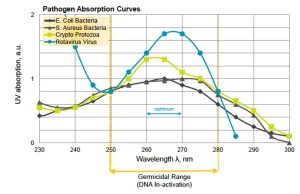
It has been long believed that the wavelength of 253.7 nm is the most efficient in terms of germicidal inactivation effect. However, germicidal effectiveness of UVC light is based on the photon’s absorption by microbial or viral nucleic acid DNA or RNA. As follows from Figure 1, built on the data from reported publications, the optimum germicidal range for bacteria, viruses and protozoa is at a wavelength of approximately 260 nm to 270 nm, where the microorganism becomes damaged due to subsequent pyrimidine dimerization and injuries of repair systems. At a wavelength of 265 nanometers, the UVC penetrate in the heart of bacterial or viral structures to damage the nucleic acids (DNA and RNA) and inactivate them.
The wavelength dependence of food pathogen bacteria reported by Green et al. (2019) shows the lowest value of fluence for 1-log reduction at 268 nm for listeria and salmonella and 259 nm for E. coli. Increasing the wavelength to 370 nm resulted in a dramatic drop of disinfection effectivity and an increase of 1-log reduction dose by more than 1 order of magnitude.
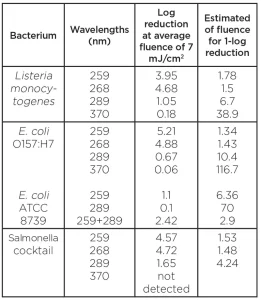
The reported data suggest that the sensitivity of human SARS-CoV-2 also is wavelength-dependent with 267 nm ~ 279 nm > 286 nm > 297 nm. A similar trend was reported for other viruses (See Table 1).
Gerchman et al. (2021) reported the UV dose (mJ/cm2) for 3-log reduction of coronavirus hCoV-OC43 (see Table 2).
These differences in bacterial and viral inactivation action of UVC, UVB and UVA light, with complexity of structure and optical properties of foods or contact surfaces, suggest that a combination of wavelengths can be used as a hurdle solution for enhancing efficacy of UV light. Smart optimization of wavelengths and their combination improve microbial and viral efficacy and performance of UV LEDs for specific organisms and applications. Short UVC LED wavelengths are costly, with low fluence rate, and require much higher dose and exposure to achieve required reduction. Simultaneous UVC+UVB+UVA exposures can result in additive or synergistic effects because food pathogens have different UV wavelength sensitivity and allow a complementary role of catalyst in the inactivation of microorganisms.
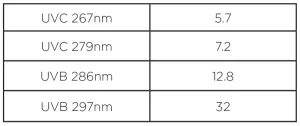
When E. coli bacteria first were pretreated with low effective UVB LEDs at 289 nm and then treated with UVC LEDs at 259 nm, the reduction of E. coli increased by two-fold and combined UV fluence for 1-log reduced (Table 1, Green et al 2019).
This microbiology-driven hurdle approach has been used in the Klaran TRILOGY UV product line from Crystal IS, which employs a combination of UVC, UVB, UVA diapasons 265 nm + 290 nm + 365nm to effectively reach and inactivate the microbial target. Al-Nitride Klaran LEDs at 265 nm, with the peak of optimal disinfection and in combination with UVB or UVA LEDs, were proved effective in inactivation of SARS-CoV-2, Escherichia coli, listeria or staphylococcus aureus. TRILOGY UV can use combinations of UVA + UVC or UVB + UVC.
Use of UV LEDs results not only in optimal efficacy on complex surfaces and in a system’s longer lifetime but also allows other essential benefits of LEDs, such as low power draw, robustness, nontoxicity, energy efficiency, design and operation flexibility, instant on and off, no glass or mercury, no ozone production and environmentally friendly. A technology called STERILUV was implemented by Concept Light (France) and recently introduced to restaurants in France.
STERILUV LEDs units for food services
SterilUV employs Klaran LED modules to build disinfection systems for treatment of air, moving surfaces of packages and food, and complex stationary surfaces using a portable device (Figure 2).
Zero COVID and pathogens in restaurants
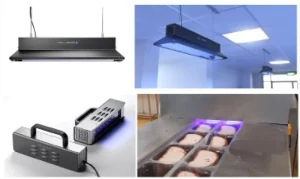
A concept called “Zero COVID,” built on the application of STERILUV COMPACT portable devices, has shown to be extremely effective in different steps of clients’ service and meal preparation in the restaurants. As reported in numerous publications, the essential advantage of UV technology for foods is its effectiveness against foodborne, airborne and waterborne pathogens without causing changes in color, sensory effects, flavor and nutrient content.
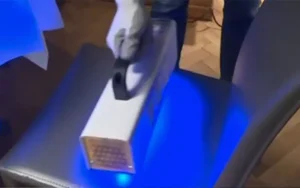
First, the STERILUV device can be introduced successfully to disinfect and prepare rooms and the surfaces of tables and chairs in the restaurant facility prior to food service (Figure 3). To prevent cross-contamination of nonfood contact surfaces, it can disinfect frequently touched surfaces of sinks, taps, toilet surfaces, handles, staircase handrails and doors during a few seconds of exposure. The device has built-in treatment indicators using an orange light indicator that becomes blue after required UV dose is delivered at 25 cm.
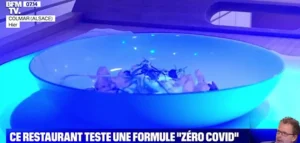
Then, the STERILUV device is effective during meal preparation in the kitchen to prevent the risk of cross-contamination of food contact surfaces from the kitchen to the customer. Also, the disinfection of the ingredients and prepared meals is conducted upstream in the kitchen (Figure 4).
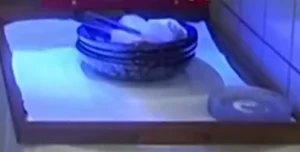
As the final step, after the meal has been consumed and when the waiter brings the dishes back to the kitchen, the STERILUV device has been used to treat dishes with UV to prevent the contamination of the dishwasher from the customer and the waiter (Figure 5).
These steps of UV disinfection not only reduce the risk of COVID transmission and infections in the restaurants but also provide peace of mind to the owners and clients.
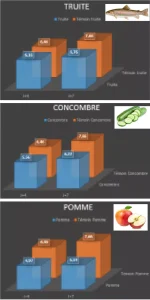
The effectiveness of the STERILUV COMPACT unit with the TRILOGY UV was confirmed by treatment of the surface of fish, vegetable and apple products at 25 cm from the product. The reduction of total microflora from 1 to 2.5 log after a few seconds of exposure was confirmed (Figure 6) after microbiological testing (UMR Inserm 1092, RESINFIT, Limoges University IFR GEIST, Medical Faculty Pr Sophie ALAIN).
The advantages of UV LEDs – such as no mercury, no chemicals, organic, dry, ecological and microbiologically safe applications – will drive interest in and growth of their application in food services. Still, the LED devices in food service have to meet food standards, be well-designed and be commissioned UVC installations. The education, signage and use of safety switches and protection equipment can help to avoid overexposure and safety of the operation and maintenance personnel.
Contact: Dr. Tatiana Koutchma, [email protected]
References
- Yoram Gerchman; Hadas Mamane; Nehemya Friedman; Michal Mandelboim. UV-LEDs vs Coronavirus-Wavelength effect, IUVA 2021. Poster February 2021 DOI: 10.13140/RG.2.2.28630.37449
- Green et al. 2019. Inactivation of Escherichia coli, listeria and salmonella by single and multiple wavelength ultraviolet-light emitting diodes. Innovative Food Science and Emerging Technologies 47 (2018) 353–361

